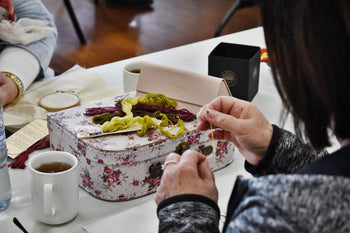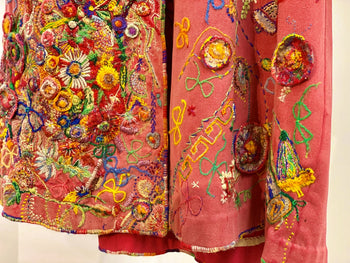colour brings us joy, and that’s all that matters
When your workplace is a rainbow of colour, like ours, it’s inevitable that we end up talking about which colours we are drawn to and why, and just how colour makes us feel. When we pause to think about what it would be like to work in grey and beige buildings, we feel so lucky we get to do what we do in this riotous place of colour.
There's something quite magical about it, white thread cones come in the door and threads of all colours go out. Katie likens it to an explosion of colour which inspired the embroidery ‘magic happens here’, as if a Cottage Garden full of colourful flowers and foliage grew inside our building so fast and large that it burst out of the windows and doors. You can stitch your own magical thread factory with the work cushion pattern.


We’re curious about the subjective experience of colour. Why do individual colours seem to carry a particular emotional charge? Do colours explain our personality traits and could they influence the way we act as well as the choices we make? As stitchers, we certainly understand the minute differences between hues of embroidery thread / floss. We can instantly fall in love with a thread colour and know they are the one, or antagonise for hours because nothing feels quite right.
These questions led us down the rabbit hole that is the ‘psychology of colour’. We have been immersed in colour since day dot, so what can a few hundred years of thinking and writing about the relationship between colour and human behaviour tell us about our experience of colour in our everyday world?
It turns out to be pretty complex. Not least, because the mechanism of how we individually perceive colour is still something of a wonderful mystery.
We've been told that certain thread colours cause a visceral reaction, take one’s breath away or raise goosebumps. Have you ever had a strong reaction to a colour?
Colours and Personalities
Take one of the giants of Western philosophical thought like Johann Wofgang von Goethe (pronounced Gurt-eh). He was a totally 18th century renaissance creation – a poet, artist, writer, scientist and politician all rolled into one. From his many perspectives, he gave the subject of colour psychology a serious work over. His Theory of Colour published in 1810 he considered to be his greatest legacy. So much so that he was apparently heard to say that ..”in my century I am the only person who knows the truth in the difficult science of colours…”.
Many people went on to say that Goethe didn’t develop a “scientific” theory about colours at all. Instead, he simply described the phenomenon of colour perception. Why we can sometimes find ourselves arguing black and blue (pardon the pun) that a colour is a bluey-green not a greeny-blue, because there may be individual biases at play such and not limited to culture, trends, and even upbringing.

The beautiful “rose of temperaments” diagrammatic that Goethe developed with his colleague Schiller in 1788 is a colour wheel that demonstrates how he thought that we perceive colour in the world around us. Goethe thought that when we perceive one colour, we automatically perceive it’s opposite and keep going until we’ve seen the entire visible spectrum of colours. As he wrote: “yellow demands violet, orange [demands] blue, purple [demands] green and vice versa.”
He took colours in the visible spectrum and matched them to the ancient Greco-Roman theory that diversity of human character can be boiled down to mixtures of 4 fundamental personality types:
- The sanguine - optimist and social
- The choleric - highly energetic, ambitious along with quick tempered
- The melancholic - the wistful and serious person
- The phlegmatic -patient and calm

Which one are you? Let’s see if your colour preferences line up with Goethe’s theory…
Remembering that this was the 18th century, his romantic line-up of human characters included “tyrants” “heroes” “joy seekers” and “poets”.
Red
Red symbolised to Goethe the quality of rationality and beauty and nobility. He thought a pure hue of carmine red “conveys an impression of gravity and dignity and at the same time of grace and attractiveness”. He associated red with the choleric personality.
The colour red is said to symbolise courage, passion, danger – it reflects heat and passion and because of that, interior designers and decorators say that it should be used sparingly, as highlights. But what if you just like it so much that you want to use it everywhere? Is it possible to have too much red? In Chinese tradition we understand that red signifies good fortune. Clearly you want as much of that as possible.
And another of our favourite theories is the claim that men and women perceive the colour red differently because the X- chromatic make-up of women makes us more able to perceive minute differences between hues of red than men.
Yellow
Goethe loved yellow. He described it as the “colour nearest the light [and that] in it’s highest purity it always carries with it the nature of brightness, and has a serene, gay, softly exciting character” and was therefore also associated with the sanguine personality type.
Yellow is said to represent sunshine – happiness, optimism, enlightenment – and as a hue in interior design is said to be welcoming because it literally warms the heart.
Did you know that certain colours can make some people actually feel sick? Yellow (or certain hues of yellow) can cause dizziness and nausea. Apparently you’ll never find yellow used inside planes or other forms of transport!
Green
Green was associated with intellect, usefulness and things that are good joy seekers, lovers and poets – the sanguine personality. Goethe felt that mixing of the primary colours yellow and blue, when done in perfect balance, gives the eye “a distinctly grateful impression ..(so that) the beholder has neither the wish nor the power to imagine a state beyond it”. Green, he thought, was the best colour for rooms that people were to live in.
CGT chose green as our signature colour because it evokes feelings of calm, of growth and nature. Green is also a colour that mixes incredibly well – designers may say that green is a primary colour in terms of its importance to us. Joanna Kabanoff spoke of green as her favourite colour in our meet the designer blog post - Stitching a sense of place. [Click to read blog]
From the blog - It’s no accident that Pam gives the same answer [green] when asked what colour is most difficult to perfect in thread. Perhaps the complexities of the hue are the very thing that make it speak to the soul. “People see colour very differently, but apparently, the human eye has the capacity to see more shades of green than any other colour”, says Joanna.
Blue
Blue didn’t fare so well in Goethe’s scheme. The spectrum of cyan – blue he associated with the phlegmatic personality – represented by public speakers, historians and teachers! He sensed blue to have a “peculiar and almost indescribable effect on the eye”. He thought it a powerful colour, but on the negative side. He decided that “rooms which are hung with pure blue appear in some degree larger but at the same time empty and cold.” Does this still hold true for us?
Blue is now apparently nearly everyone’s favourite colour. There are worldwide studies showing that 40% of people say that blue is their favourite colour. With purple in 2nd place with 14% of people citing it as their favourite.
And did you know that blue hasn’t always been the colour culturally associated with boys and pink with girls? That in earlier times it was completely the opposite? Or that the ancient Greeks believed that blue-eyed people were the most effective at delivering the curse of the evil eye?
Our office administrator Caylie’s favourite colour is a pure mint green but she also has the grapheme-colour form of synaesthesia which means that she perceives letters and numbers to be associated with colours. Days of the week are coloured. And Thursdays are blue. They just are.
Purple
And where blue mixes with red, the spectrum of violet-magenta-red, Goethe placed the melancholic personality type – the philosophers, pedants and rulers of his 18th century world. Red and blue to his mind produces colour hues infinitely more disturbing than the joyous mixing of red with yellow. He thought purple an “unquiet colour’ and it wasn’t lost on him that it was a colour very much favoured by royalty.
With purple apparently being people’s 2nd favourite colour, here at CGT our individual colour preferences seems to roughly follow that statistic – although what’s truly fascinating is how polarising purple is in our workplace. While CGT’s demon twister Kay’s favourite colour of all is the violet hue of jacaranda flowers, our master dyer Pam has a form of synaesthesia which allows her taste and smell the colour purple. Only purple – no other colour - and it’s not a good experience.
Interestingly, purple was a very hard colour to produce and therefore very expensive. The word purple derives from Latin ‘purpura’, the name of the Tyrian purple dye produced from the secretions of spiny Pupura Haemostoma molluscs. The Cottage Garden Threads dye team is certainly glad that the Pupura molluscs can live their lives in peace now that purple dye is more readily available. Once scarce and reserved for royalty, but now available to anyone who desires it, we wonder if purple still holds the same power?
And perhaps it’s no accident that one hundred years later in 1901, suffragette women, so long denied any position of power in the church or state, co-opted the colour purple as their own.
The suffragette flag contains purple representing royalty – as a symbol of “the royal blood that flows in the veins of every suffragette – the instinct of freedom and dignity; along with white for purity and green to represent hope and the emblem of spring.

Orange
Goethe grouped Orange with Yellow but we think it deserves a word or two all to itself.
Zoe from Cottage Garden Threads fulfillment team loves Orange and says, “we don’t have nearly enough”. Zoe is excited about the Pantone colour of the year for 2024.
Pantone is an American company that has developed extraordinary proprietary colour matching systems for design, manufacture and marketing which have become ubiquitous around the world. Pantone’s colour system has become the universal standard with which all colour can be measured and communicated.
Pantone has nominated a Colour of the Year since 2010 and its impact can be felt across fashion, cosmetics, home furnishings, automotive and industrial design as well as products and multimedia design. Pantone’s 2024 colour is called Peach Fuzz.
Pantone describes Peach Fuzz as “a heartfelt peach hue bringing a feeling of kindness and tenderness, communicating a message of caring and sharing, community and collaboration.”
What did we discover when we followed our curiosity and fell down the rabbit hole of colour psychology? There is a rich tapestry of theories and speculations about how we perceive and integrate colour into our lives. The subject of colour is, like so many other aspects of our lives, very nuanced, influenced by so many factors, including culture, trends, and even upbringing.
We are content in knowing that colour does indeed have a psychological, emotional and sometimes even physical response, but are satisfied to leave it a mystery and simply celebrate colour because regardless of who we are and our individual responses, colour brings us joy, and that’s all that matters.









